Written on: August 1, 2012 by SprayTM
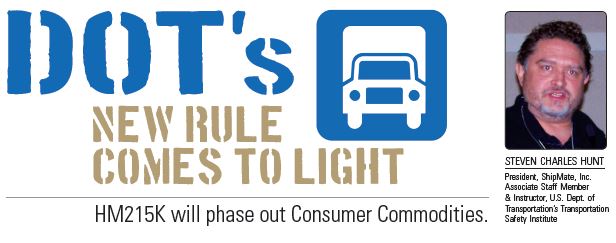
The Jan. 19, 2011 final rule, HM-215K, published by the U.S. Dept. of Transportation’s Pipeline & Hazardous Materials Safety Administration (PHMSA) is, perhaps, one of the most significant rulemakings since its landmark rulings, HM-181 (adopts the international standards for hazardous materials transportation) and HM-126F (requires hazardous materials training).
The final rule, which went largely unnoticed by the regulated public until this year, includes sweeping changes in the requirements for the transport of limited and excepted quantities of hazardous materials (also referred to as “dangerous goods.”) Most significantly, PHMSA signaled its intent to eliminate the Consumer Commodity ORM-D classification and adopt the international markings and documentation requirements for limited and excepted quantities.
PHMSA’s intent in this final rule was to eliminate confusion by shippers as to when and where the ORM-D classification and marking could be used. Prior to 1990, the U.S. Dept. of Transportation (DOT) had five different ORM (other regulated material) classifications: ORM-A, ORM-B, ORM-C, ORM-D and ORM-E. When HM-181 became effective, four of the five ORM classifications were eliminated; the only one that survived the cut was ORM-D, which was assigned a proper shipping name of either Consumer Commodities or Cartridges, Small Arms. Consumer Commodities were smaller quantities of hazardous materials intended for personal care or household use, and the Cartridges, Small Arms shipping description applied to rifle and pistol ammunition.
Over the past 20 years or so, there have been several attempts to eliminate the ORM-D classification, but each proposal ended in defeat and the ORM-D classification marched on…until HM-215K that is. This “new” final rule will align the U.S. with the rest of the world and phase out the Consumer Commodity proper shipping name and ORM-D classification.
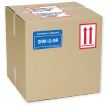 The final rule includes two very important deadlines that must be complied with. The first is Jan. 1, 2013, at which time the ORM-D-AIR marking becomes obsolete and is replaced by the new limited quantity “Y” marking for air transport. The second deadline is Jan. 1, 2014, when the Consumer Commodity and ORM-D classification is eliminated for all other modes of transport. HM215K will phase out Consumer Commodities.
The final rule includes two very important deadlines that must be complied with. The first is Jan. 1, 2013, at which time the ORM-D-AIR marking becomes obsolete and is replaced by the new limited quantity “Y” marking for air transport. The second deadline is Jan. 1, 2014, when the Consumer Commodity and ORM-D classification is eliminated for all other modes of transport. HM215K will phase out Consumer Commodities.
Compliance with these new requirements was authorized on Jan. 1, 2011. However, compliance with the new limited quantity markings was required for air and ocean transport on Jan. 1, 2012.
How Does the Rule Affect You?
If you are a manufacturer or distributor of aerosols, cosmetics, paint stores, after-market auto care products, cleaning supplies or other limited quantities of dangerous goods that are offered, intended or suitable for retail distribution, you will be affected by this rule.
 Marking & Labeling
Marking & Labeling
The new limited quantity marking consists of a diamond (square-on-point) with a black border and “black points” in the top and bottom quadrants of the diamond (see illustration at right). While the limited quantity marking shown in the various regulatory references and those which are available from commercial suppliers are black on a white background, DOT did further clarify that the marking need only be black on a contrasting background.
In other words, a black designation printed on Kraft is acceptable provided there is adequate contrast. Black on a dark-colored box (e.g., blue, purple) would not be acceptable, for example.
The marking and labeling requirements will differ depending upon mode of transport.
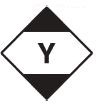 Air Transport
Air Transport
For air shipments of limited quantities and those currently classified as ORM-D and tendered to small package air carriers, such as UPS Air, the ORM-D-AIR marking must be replaced with the required hazard warning label and the new limited quantity “Y” marking (as shown below).
While it is not difficult to comply with these new requirements, many shippers will find that their shipments will become “frustrated” and ultimately rejected by the airline because the marks and labels are not applied properly, the box is too small to fit the required marks and labels and the dangerous goods declarations are not properly prepared. Adding insult to injury, many shippers may see a spike in the hazardous materials surcharges because these shipments will require a hazard warning label, whereas ORM-D-AIR shipments did not require a hazard warning label under the old rules.
In order to accommodate the hazard warning label and new limited quantity “Y” marking, packages of “consumer commodities” must have minimum dimensions of at least 9″ square on one side. A minimum height and width of 9″ is necessary in order to allow the hazard warning labels (4″ on a side) and the limited quantity “Y” marking to be applied to the surface in a diamond configuration (see the schematic diagram below). Although DOT does permit a smaller (50mm x 50mm) limited quantity “Y” marking, there are no similar exceptions for a reduced hazard-warning label.
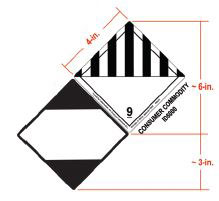 In addition, packages intended for transport by aircraft must have the corresponding proper shipping name e.g., AEROSOLS, FLAMMABLE or CONSUMER COMMODITY) and identification number (e.g., UN1950 or ID8000, respectively) applied next to the hazard warning label (e.g., flammable gas – class 2.1, miscellaneous – class 9, respectively).
In addition, packages intended for transport by aircraft must have the corresponding proper shipping name e.g., AEROSOLS, FLAMMABLE or CONSUMER COMMODITY) and identification number (e.g., UN1950 or ID8000, respectively) applied next to the hazard warning label (e.g., flammable gas – class 2.1, miscellaneous – class 9, respectively).
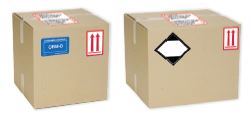 Other Modes
Other Modes
The marking requirements for surface (road and rail) and ocean transport are a bit more palatable than by air, but might still have an impact on your package designs. Under the old rules, a Consumer Commodity ORM-D marking required a quarter-inch space around the ORMD designation, which was placed within a rectangle, and required the words “Consumer Commodity” to appear above the rectangle (see illustration below). Minimum box dimensions were 1″ high, whereas the minimum box height and width under the new rule is 3″ square. The increased minimum box dimensions will enable the shipper to apply the reduced size limited quantity marking in a diamond configuration on the side of the box (see illustration below). quantity “Y” marking (see illustration below) requires that the requirements for air transport are also met. It is important to note that use of the limited quantity “Y” marking only may cause confusion among small package dispatch services, such as FedEx and UPS, because they will think that you intend to ship the package by air and the required proper shipping name, identification and hazard warning labels are missing. This confusion will result in a “frustrated” shipment and may even earn you a “strike” under UPS’ two strikes policy.
Packaging
The final rule requires all limited quantities packaging to be capable of withstanding certain performance tests including a 1.2 meter (4′ high) drop test and a 3-meter (10′) stacking test. Additionally, packages of limited quantities intended or offered for transport by aircraft must be capable of passing the pressure differential test specified in Title 49, Code of Federal Regulations, §173.27(c). While the rules state that packaging must be capable, the reader is strongly cautioned to either obtain a written test report or maintain documentation, which proves that the packaging is capable of passing the prescribed tests. This information will be particularly useful when a DOT or Federal Aviation Administration (FAA) enforcement agent visits your site and demands proof of compliance.
Shipping Papers
The DOT did, however, carry over one of the benefits from the old Consumer Commodity ORM-D requirements the exception from shipping papers for road and rail transport. Under the newly aligned limited quantity provisions, packages of limited quantities do not require shipping papers for road and rail transport (including shipments to/from Canada).
The shipper may, however, tender a shipping paper with the consignment that declares the material in the new basic sequence, followed by the words “limited quantities,” or the letters “LTD QTY.” For example, a shipment of twelve 10oz. cans of hairspray may be documented on a Bill of Lading as:
UN1950, AEROSOLS, 2.1, LTD QTY
It is important to note that many road and rail carriers often charge a hazardous materials surcharge if a shipping paper is offered.
Air & Ocean Transport
Dangerous goods declarations are required for air and sea shipments and must describe the consignment in the sequence previously shown. Again, the words “limited quantity” or the letters “LTD QTY,” must follow the basic description. It is important that no other abbreviations for “limited quantity” are authorized. In addition to a Shipper’s Declaration of Dangerous Goods, air shipments must also have an Air Waybill, which includes the notation:
DANGEROUS GOODS AS PER ATTACHED DECLARATION
It is also important to note that air shipments of limited quantities intended for personal care or household use (Consumer Commodity) are assigned to Class 9 and assigned an identification number of ID8000 and a new Packing Instruction Y963. Additionally, the letters “LTD QTY” are no longer required to be shown in the Authorizations column of the Shipper’s Declaration of Dangerous Goods (candy-stripe form). An excerpt from a shipping paper tendered for air transport is shown below.
 Other Considerations
Other Considerations
While most of the focus in this article has been given to marking, packaging and documentation, there are other important considerations that should be taken into account. These include segregation, marking of freight containers for ocean transport, driver requirements, stock rotation and the Globally Harmonized System of Classification
& Labeling of Chemicals (GHS).
Segregation
The limited quantity provisions will generally forgive the shipper from the required segregation; however, many ocean carriers still require limited quantity consignments to be segregated from incompatible materials within intermodal freight containers. For example, many hair care product manufacturers offer limited quantities of hair bleaching compounds and gels. Many of these bleaching compounds are classified as Class 5.1 oxidizers and hair gels and pomades are often classified as Class 3 flammable liquids. Fully regulated shipments of these products are not permitted to be packed within the same intermodal freight container.
Even though the International Maritime Dangerous Goods (IMDG) Code (3.4.4) states that the “…segregation provisions of Chapter 7.2 are not applicable for packaging containing dangerous goods in limited quantities or in relation to other dangerous goods,” many conservative ocean carriers do not allow shipments to be carried under this exception as a matter of business policy. Therefore, the shipper is encouraged to review carriers’ limited quantity acceptance provisions before packing intermodal freight containers.
Marking of Freight Containers
Intermodal freight containers carrying dangerous goods only in limited quantities must be marked with the “enlarged” limited quantity markings on each of the four visible sides of the freight container.
The “enlarged” limited quantity marking is required on the freight container when all of the dangerous goods in the freight container are limited quantities, regardless of the volume it occupies within the freight container. For example, if a 20′ freight container has a capacity of 30 cubic meters, and it contains one cubic meter of dangerous goods in limited quantities and the balance is nonhazardous cargo, the “enlarged” limited quantity marking would be required on the exterior of the container. If however, a freight container contains any amount of a hazardous material requiring a hazard-warning label (e.g., a five-gallon pail of a flammable liquid), the “enlarged” limited quantity marking would not be applied, but would be replaced with the required placards for the cargo requiring a hazard warning label.
The “enlarged” limited quantity marking have dimensions of 250 mm x 250 mm (9.82″ square) and are often confused with hazard warning placards having similar dimensions. Consequently, many drayage companies are dispatching or charging higher premiums for “hazmat endorsed” drivers.
Driver Requirements
Any driver that transports fully regulated hazardous materials or limited quantities of dangerous goods, or both, is required to have, as a minimum, the four types of training specified in 49 CFR part 172, subpart H. These include: (a) General Awareness & Familiarization; (b) General Safety; (c) HM Security Awareness; and (d) Function- Specific training (e.g., loading/unloading, segregation, carriage).
A hazardous materials endorsement to the Commercial Drivers’ License is required for drivers that transport hazardous materials, which require a hazard-warning placard. An endorsement is not required for shipments of limited quantities, unless the carrier is also carrying a placardable quantity of other dangerous goods. Shippers are urged to review the provisions of 49 CFR 172.500(a) – Applicability.
This is important for shippers to take note of this as many carriers are dispatching endorsed drivers because they erroneously assume that the “enlarged” limited quantity marking is a “placard.” Consequently, many shippers are being charged with a surcharge for the specialized driver. In some cases, this may be as high as an extra three to four hundred dollars per cargo transport unit.
Stock Rotation
As the deadline for implementation of the new limited quantity markings approaches, it is important to consider rotating old pre-printed stocks of ORM-D material to avoid repackaging or labeling. After the implementation dates, deadlines, there will no exceptions from the marking requirements.
Shippers are urged to consider this carefully before ordering a year’s worth of inventory. For those shippers that offer limited quantities by air, you should lean your inventory as much as possible and consider transitioning to the new requirements well in advance of the Jan. 1, 2013 deadline.
Manufacturers and distributors of limited quantities should also consider working with packaging design firms and suppliers in advance of the implementation dates. It
is important to note that many packaging design and fabrication firms are not familiar with these new rules, so you may have to educate them accordingly before a considerable amount of time, money and resources are wasted.
GHS Implementation
The adoption of the Globally Harmonized System of Classification and Labeling of Chemicals (GHS) by the U.S. Occupational Safety & Health Administration (OSHA) on March 20, 2012 requires all chemical substances, including limited quantities of hazardous materials, to be classified and marked with new pictograms, warnings, and hazard and precautionary statements.
Although the implementation date for GHS is not until July 1, 2015, the next 18 months may be a good time to take a hard look at your chemical labeling and packaging. There may be an opportunity to take advantage of economies of scale available if your point of sale packaging and transportation package is redesigned at the same time.
In Conclusion
Although limited quantities of hazardous materials will once and for all be harmonized throughout the world, the transition to these new rules may be slightly painful, confusing and costly. However, the costs to transition may be substantially reduced if you plan now.
Start by reviewing the requirements of HM215K or consulting experts in this field. A little planning and investment right now will help you through this transition and significantly ease the burden. Do not wait until it is too late.